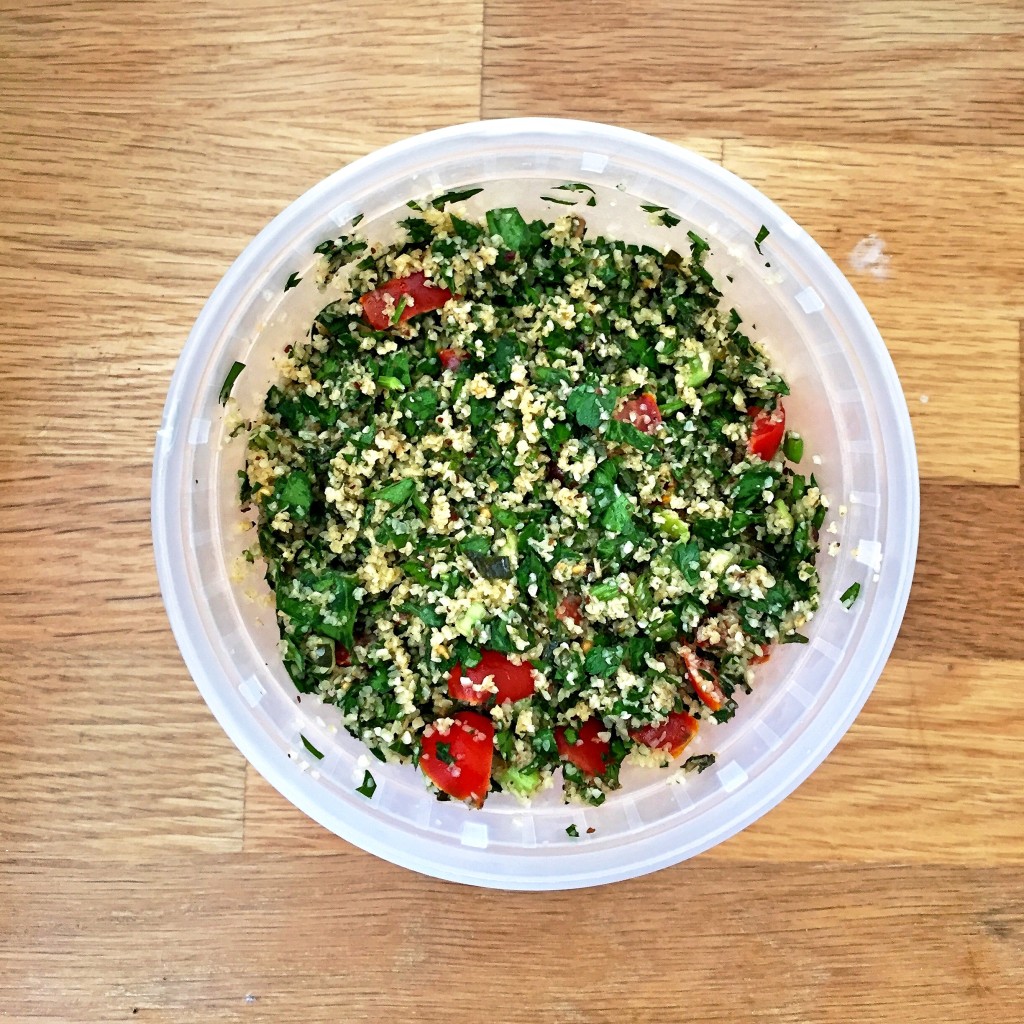My tabbouleh recipe is the trial-and-error type, tested over many dinners, with improvements occurring all the time. I do not have one single recipe, as it is a work in progress, developed to my taste, but I do have two beliefs about tabbouleh that I try to stick to.
The herbs are the best part of this salad, so both the parsley and mint need to be thoroughly cleaned, or otherwise you end up biting into bits of sand/dirt. You can wash the parsley and mint by dunking it in a bowl of water several times (and changing the water as needed). You can gently pat the herbs by laying them on a towel, or leave them on the counter to dry. The herbs are less mushy, more crisp, if revived with a quick water bath and left to dry.
The next thing most tabboulehs contain is a grain, or filler of some sort, if you will. Bulgur is the traditional go-to.  In the recipe below, you will see I use bulgur #1, the finest, smallest grain. I have found it in the international aisles of grocery stores, in natural food stores, and also in specialty markets. Other types, or grades, of bulgur or dried cracked wheat that you may find in stores work, too, but the size of the grains will affect how much water you use, and overall consistency. If you cannot find bulgur, or do not eat wheat, quinoa and couscous are fine substitutes.
Tonight’s Tabbouleh

Ingredients (serves four as a small salad or two generous servings for dinner):
1/2 cup bulgur #1/ bulgur fine
1/2-1 teaspoon ground sumac
1/4+ teaspoon garlic powder, adjust to your preference
one pint of cherry tomatoes
pinch of salt
1 lemon
1 tablespoon of extra virgin olive oil
1/2 cup+ of water
one large bunch of washed parsley (see note above about washing)
half a smallish bunch of washed mint
small bunch of scallions (about 5-6, depending on size), finely sliced
one Persian cucumber, peeled and diced
about two tablespoons of red wine vinegar
additional extra virgin olive oil, optional
Steps:
1) I begin by cutting the tomatoes in half, or quarters, depending on the size. Place the bulgur in a glass bowl, add the ground sumac and powdered garlic, and mix. Instead of leaving the tomato juice on the board, put it in with the bulgur. Also, put the chopped cherry tomatoes in a colander over the bulgur, and toss with a smallish pinch of salt. Let the tomato juice drain over the bulgur for a couple of minutes.
2) Meanwhile, cut the lemon, and squeeze half of the juice on the bulgur in the bowl. Put the bulgur with the juices and a tablespoon of extra virgin olive oil in the microwave for one minute, stopping halfway to fluff with a fork. The grain will start to slightly sizzle, so keep an eye on it.
3) Take the bulgur out of the microwave, and it will smell like it is lightly toasted (the liquid is absorbed, and color has changed to a darker shade). Immediately add the water and squeeze the other half of the lemon into the bowl. The bulgur will absorb the liquids quickly, so stir a few times, before placing in the microwave for another two minutes, checking halfway again. Taste at the one minute mark to make sure the bulgur is not too hard, but also not mushy. The consistency you are aiming for is al dente, or slightly underdone. Adjust for more water, if needed. Take out of the microwave, fluff with your fork, and leave to cool down.
4) To chop the parsley, cut off as much of the stems as possible, or pinch the leaves from the stems. Don’t discard the stems though, as they can be added to broths. It doesn’t have to be perfect, but the less coarse stems, the better the taste. Chop the parsley, aiming for medium to fine. You can make sure no large pieces or leaves are left, or just call it done. Place on a plate, bowl, side of the board…just not in the bulgur yet, as it may be hot, but, if your bulgur has cooled down, then by all means add the parsley in.
5) Pinch the mint leaves from the stems, as you did with the parsley. Here you want to take care to remove the leaves completely as the stems tend to be too large and woody to eat. Mint stems make great mint tea, so these don’t need to be tossed either. Chop the mint finely, and add to the bowl, along with the scallions and cucumber.
6) Add the red wine vinegar, and combine. Taste to see if you would like more olive oil, or salt. I usually add just a little of both, adjusting as needed. You can refrigerate the tabbouleh for a day or more, but I like to serve it immediately, with toasted pita bread. For dinner, stuffed pita pockets with hummus, tabbouleh, and yogurt or tzatziki are my favorite. When it comes to meat, lamb is a good accompaniment to this salad.
